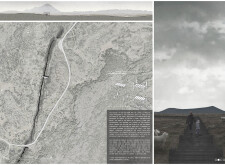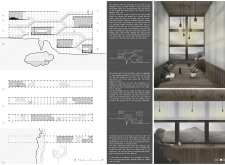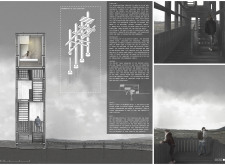5 key facts about this project
The project features several distinct sections, including observation decks, social gathering spaces, and educational areas. These components are organized to enhance visitor experiences, providing varied vantage points for viewing the fault line and its geological significance. The overall form of TURNBRU adopts a curving geometry, echoing the natural undulations of the landscape and visually bridging the two sides of the fault.
Focus on Materiality and Sustainability
TURNBRU's construction employs a range of materials that reflect both functionality and sustainability. Wood constitutes the primary structural element, chosen for its renewable qualities and aesthetic appeal. Translucent panels are integrated to allow natural light to filter into interior spaces while maintaining visual connections to the exterior. Metal framework supports the structure's integrity, providing strength against environmental challenges. The inclusion of glass enhances visibility and engagement with the landscape, creating a seamless transition between inside and out.
Concrete is utilized for foundational elements, ensuring stability on a geologically active site. This material choice balances durability with the need for a lightweight structure, critical for regions characterized by geological fault lines.
Innovative Spatial Configuration
The architectural design emphasizes spatial fluidity, allowing visitors to navigate through various zones with ease. The layout encourages movement and exploration, with strategically placed observation platforms that facilitate panoramic views across the landscape. The design fosters social interaction through communal spaces, promoting engagement among visitors. Educational elements are incorporated to enhance the understanding of geology and ecology, furthering the project's mission to connect people with their environment.
The TURNBRU project stands out due to its adaptive modularity. This design approach allows for modifications and expansions, ensuring the building stays relevant to the community's evolving needs. As such, it serves not only as a visitor center but also as a cultural hub for events and educational programs, thereby increasing its utility and impact.
Explore TURNBRU further by reviewing its architectural plans, sections, and design ideas to gain an in-depth understanding of its innovative approach to architecture and sustainability.


























